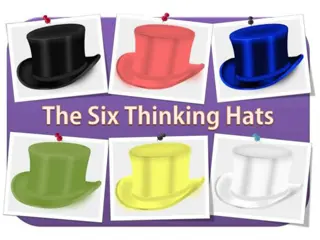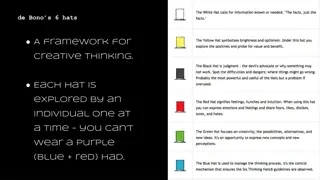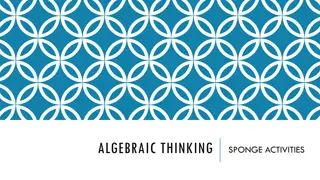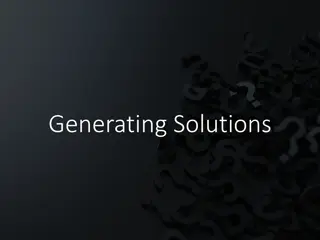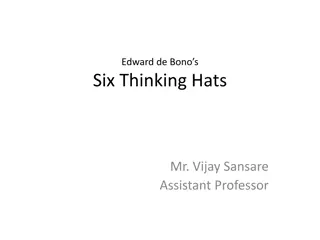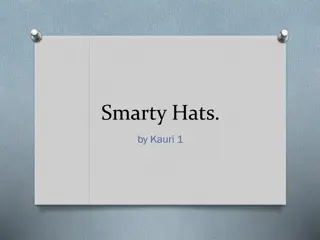Utilizing Six Thinking Hats for Enhanced Decision Making and Problem Solving
Exploring the concept of Lateral Thinking through the Six Thinking Hats technique, this article delves into how this approach by Edward de Bono can revolutionize decision-making processes. By understanding the objectives and roles of each colored hat - Blue, Red, Yellow, Black, Green, and White - individuals and groups can communicate effectively, generate innovative ideas, and promote creative problem-solving. This method aids in removing ego from decision-making, improving productivity, and fostering a holistic perspective in discussions and decision-making processes.
Download Presentation

Please find below an Image/Link to download the presentation.
The content on the website is provided AS IS for your information and personal use only. It may not be sold, licensed, or shared on other websites without obtaining consent from the author.If you encounter any issues during the download, it is possible that the publisher has removed the file from their server.
You are allowed to download the files provided on this website for personal or commercial use, subject to the condition that they are used lawfully. All files are the property of their respective owners.
The content on the website is provided AS IS for your information and personal use only. It may not be sold, licensed, or shared on other websites without obtaining consent from the author.
E N D
Presentation Transcript
Rayat Shikshan Sansthas R. B. Narayanrao Borawake College, Shrirampur, Tal. Shrirampur, Dist. Ahmednagar Dr. Ganesh V. Lokhande Class: F.Y..B.A. Subject : General Psychology (G-1) Topic: Lateral Thinking (Six Thinking Hats)
Lateral Thinking (Six Thinking Hats) For Disaster Management
Lateral Thinking For Disaster Management Lateral thinking concept delivered by Edward de Bono in 1967. According to Edward de Bono, Lateral Thinking as methods of thinking concerned with changing concepts and perception. Lateral thinking is a evaluative thinking process. Lateral thinking process differ than other thinking processes. Lateral thinking process is one of problem solving method. Edward D. Bono explain lateral thinking process in six thinking hats techniques Six Thinking Hats Technique developed by Edward De Bono in 1985
Objectives of Six Thinking Hats? To Helps us to communicate more effectively. To Increasing productivity and performance in thinking process. To generate new ideas and creative think. Use in groups also individually decision process. To promotes creative problem solving. To Increase thoughts and ideas. To solve problems instant. To depth thinking process. To saving time. To remove ego from decision making. An important and powerful technique. It is used to look at decisions from a number of important perspectives. Various type of thinking.
Six Thinking Hats Technique Blue Hat To Control Thinking Process. To Coordinator of Decision Making To Determine Goal Setting. To Control on Other Hats To Selection of the Topic for Discussion. To Leadership of Group Member. To Guidance Other Members in the Group. To Summary of Group Discussion Take Final Decisions.
Six Thinking Hats Technique Red Hat Symbol of All Emotions. Symbol of All Feelings. Symbol of Intuition. To Hunches to Others Mind. Try to Understand Reactions of the Others. Try to Understand Interest, Love of the Others.
Six Thinking Hats Technique Yellow Hat Symbol of Optimistic To Positive Thinking To Productive Think Helpful Helps to Thinking Positively. To see all the Benefits of the Discussions and Decision.
Six Thinking Hats Technique Green Hat To Creative Thinking To develop new concept for problem solving To inspiring lateral thinking process To give opportunities use of all tools of lateral thinking To develop New Ideas in discussion and decision Process. To Search New Alternatives
Six Thinking Hats Technique White Hat Realistic Symbol To Objective Thinking To Attention Present Needs and Problems. To Attention on Present Topic of Discussion. To Attention on Planning To Achieve the More Information. To Focus on the Data Available.
Six Thinking Hats Technique Black Hat To Negative Thinking. To Think Serious To Search Risk in Decisions To Careful Thinking Look at all the Bad Points of the Decision. To Evaluation of Decisions Negative Views.




